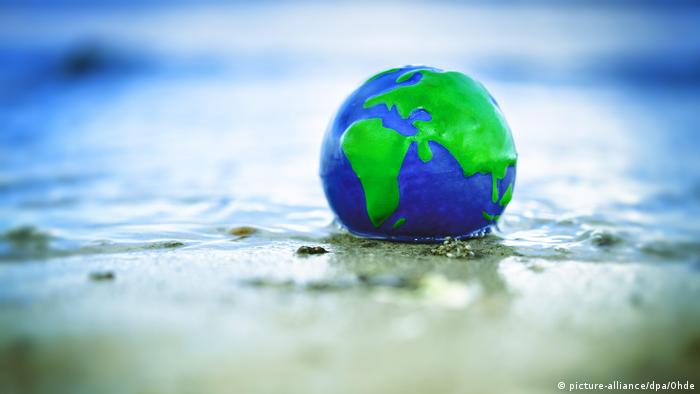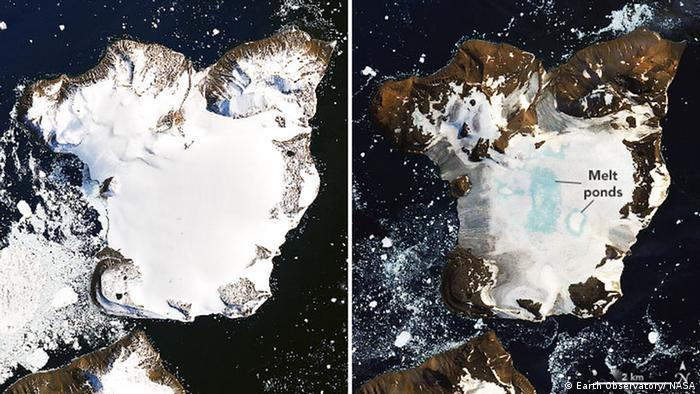Even if nations are able to limit warming, sea levels will still rise significantly, new research from Germany's Potsdam Institute shows. In a worst-case scenario, seas could rise 5.6 meters.

Global sea levels will probably rise by even more than currently predicted, scientists warned on Friday.
Even if nations are able to achieve their Paris-Agreement commitment to limit warming to 2 degrees Celsius above pre-industrial levels, the oceans will still rise by about 0.5 meters (1.6 feet) by the end of the century and as much as 2 meters by 2300, a new study found.
If nations fail to act, and current emissions lead to warming of 4.5 degrees, then sea levels are predicted to rise between 0.6 and 1.3 meters by 2100 and between 1.7 and 5.6 meters by 2300.
Read more: Hotter, higher seas to worsen extreme floods without 'urgent and ambitious' action, United Nations warns
The predictions are based on a survey of 106 of the world's leading sea level researchers, carried out by scientists from Nanyang Technological University (NTU) and co-authored by researchers from the Potsdam Institute for Climate Impact Research (PIK) and published in the Nature Partner Journal Climate and Atmospheric Science.
Mitigation is 'in our hands'
"What we do now within a few decades will determine sea-level rise for many centuries, the new analysis shows more clearly than ever before," PIK's Stefan Rahmstorf said. "But this is also good news: when it comes to greenhouse gas emissions, we have it in our own hands how much we increase the risks for millions of people on the world's coasts, from Hamburg to Shanghai and from Mumbai to New York.
The predictions are higher than those currently published by the Intergovernmental Panel on Climate Change (IPCC), which has already increased its predictions.
Read more: Could flooding be a cure for rising seas?
In September 2019, the UN climate science panel found that unmitigated climate change would lead to a sea level rise of between 0.61 meters and 1.1 meters by 2100. At the time it said the forecast could be conservative due to the speed at which Antarctic ice could melt.
Friday's report said the increased forecast came from better data and improved understanding of climate processes.
Data for decision makers
"The complexity of the sea-level rise projections and the sheer volume of relevant scientific publications makes it difficult for policy makers to gain an overview of the state of research," NTU's Benjamin Horton said in a statement.
"For such an overview, it is therefore useful to ask leading experts what kind of sea-level rise they expect — this gives a broader picture of future scenarios and provides policymakers with the information they need to decide on the necessary measures."

CATASTROPHES TRIGGERED BY WARMING OCEANS
A California day at the South Pole
In Antarctica, scientists measured temperatures on par with Los Angeles. In February, a record 18.3 degrees Celsius (64.9 degrees Fahrenheit) was measured at the Argentinean research station Esperanza Base in the north Antarctic. This was the highest temperature since measurements began there, according to NASA. The warm weather led to quickly developing melt ponds (pictured right).
FOR MORE PICTURES CLICK BELOW
1234567891011
Date 08.05.2020
Sea level could rise by more than a meter by 2100 if emission targets are not met

An international study led by Nanyang Technological University, Singapore (NTU Singapore) scientists found that the global mean sea-level rise could exceed 1 meter by 2100 and 5 meters by 2300 if global targets on emissions are not achieved.
The study used projections by more than 100 international experts for the global mean sea-level changes under two climate scenarios—low and high emissions. By surveying a wide range of leaders in the field, the study offers broader assurance about its projections for the ranges of future sea-level rise.
In a scenario where global warming is limited to 2 degrees Celsius above pre-industrial levels, the experts estimated a rise of 0.5 meters by 2100 and 0.5 to 2 meters by 2300. In a high-emissions scenario with 4.5 degree Celsius of warming, the experts estimated a larger rise of 0.6 to 1.3 meters by 2100 and 1.7 to 5.6 meters by 2300.
Professor Benjamin Horton, Acting Chair of NTU's Asian School of the Environment, who led the survey, said that sea-level rise projections and knowledge of their uncertainties are vital to make informed mitigation and adaptation decisions.
Prof Horton said, "The complexity of sea-level projections, and the sheer amount of relevant scientific publications, make it difficult for policymakers to get an overview of the state of the science. To obtain this overview, it is useful to survey leading experts on the expected sea-level rise, which provides a broader picture of future scenarios and informs policymakers so they can prepare necessary measures."
Published in Nature Partner Journals Climate and Atmospheric Science on 8 May, the projections of sea-level rise exceed previous estimates by the International Panel on Climate Change (IPCC).
The NTU-led international study was a collaboration with researchers from The University of Hong Kong, Maynooth University (Ireland), Durham University (UK), Rowan University (U.S.), Tufts University (U.S.), and the Potsdam Institute for Climate Impact Research (Germany).
"We know that the planet will see additional sea-level rise in the future," says co-author Dr. Andra Garner, Assistant Professor of Environmental Science at Rowan University in the United States of America. "But there are stark differences in the amount of sea-level rise experts project for low emissions compared to high emissions. This provides a great deal of hope for the future, as well as a strong motivation to act now to avoid the more severe impacts of rising sea levels."
"This international study is based on the informed opinions of 106 sea-level experts and underlines the critical importance of pursuing a low emissions policy to limit sea-level rise," says Dr. Niamh Cahill, Assistant Professor in the Dept of Mathematics and Statistics at Maynooth University in Ireland.
The 106 experts who participated in the survey were chosen as they were among the most active publishers of scientific sea-level studies (at least six published papers in peer-reviewed journals since 2014) identified from a leading publication database.
In response to open-ended questions, the climate change experts identified the Greenland and Antarctic Ice Sheets as the greatest sources of uncertainty. These ice sheets are an important indicator of climate change and driver of sea-level rise. Satellite-based measurements show the ice sheets are melting at an accelerating rate. However, the experts also noted that the magnitude and impact of sea-level rise can be limited by successfully reducing emissions.
Dr. Andrea Dutton, Professor in the Department of Geoscience at the University of Wisconsin-Madison, who is not involved in this study, says, "One of the key take-aways from this study is that our actions today can make a profound difference in how much our coastlines will retreat in the future. That knowledge is empowering because it means that we can choose a better outcome through our actions."
The paper, "Estimating global mean sea-level rise and its uncertainties by 2100 and 2300 from an expert survey," was published in Climate and Atmospheric Science on Friday, 8 May 2020.
More information: Benjamin P. Horton et al. Estimating global mean sea-level rise and its uncertainties by 2100 and 2300 from an expert survey, npj Climate and Atmospheric Science (2020). DOI: 10.1038/s41612-020-0121-5
Provided by Nanyang Technological University
No comments:
Post a Comment